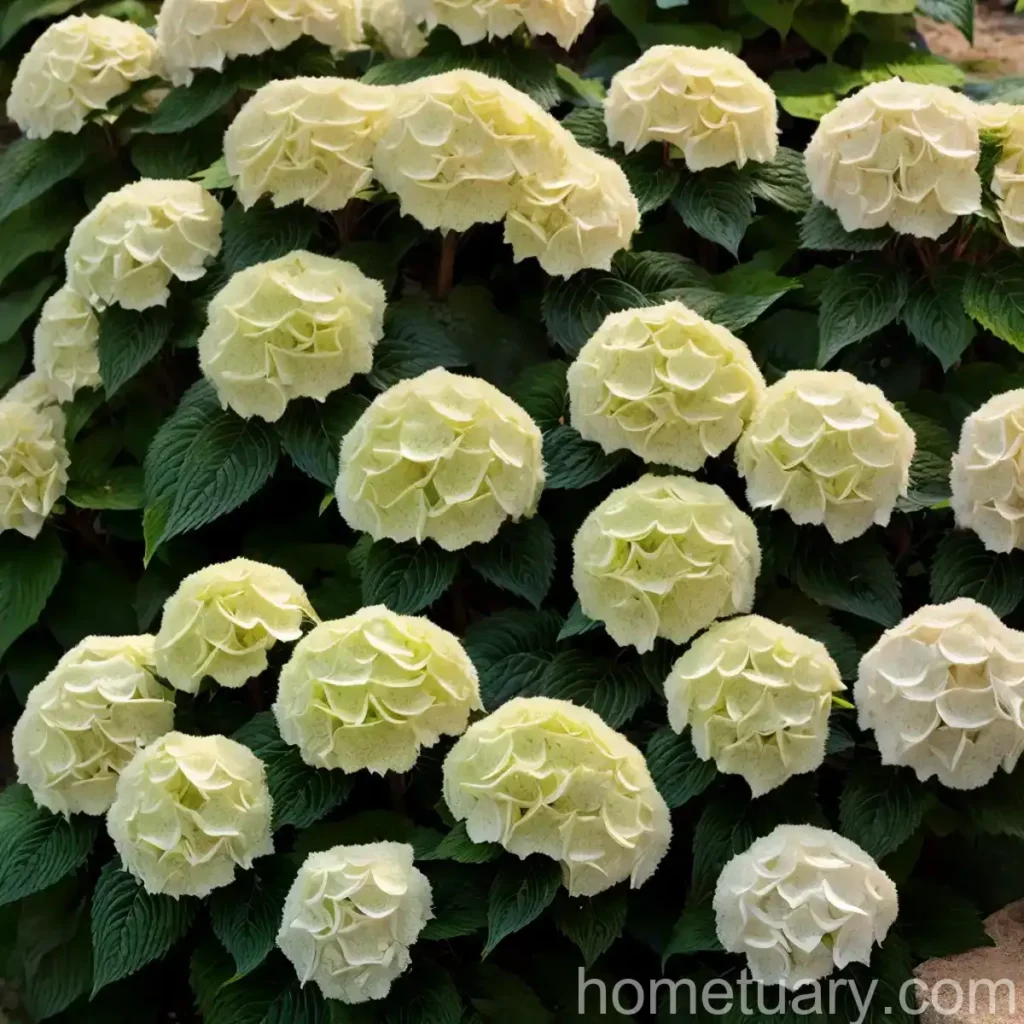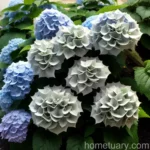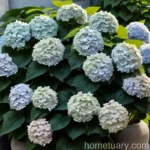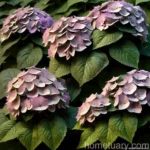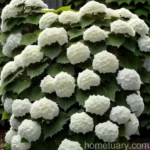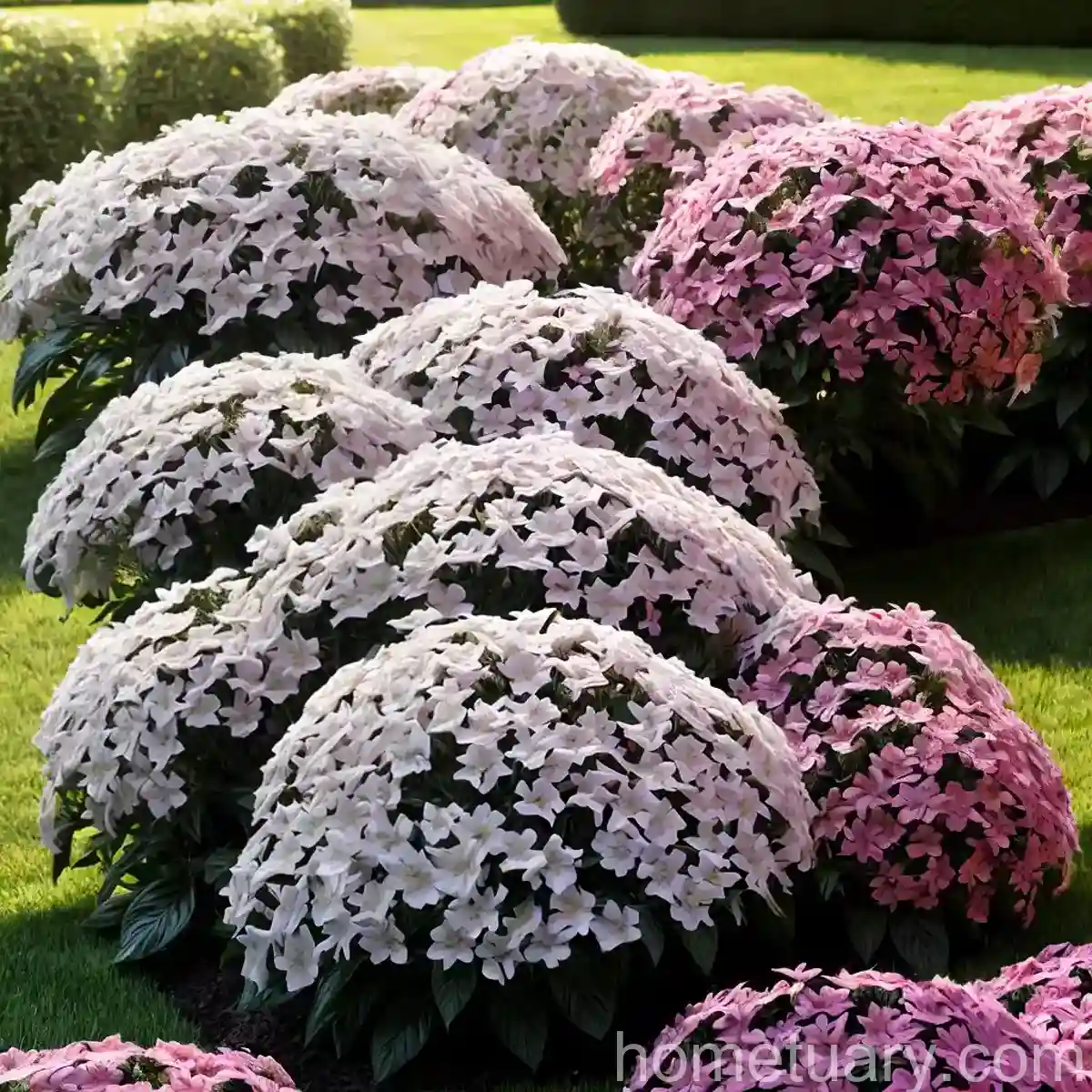Hydrangea (Hydrangea serrata ‘Golden Sunlight’)
Hydrangea serrata ‘Golden Sunlight’ is a delightful and vibrant cultivar of the Hydrangea species, known for its stunning golden foliage and captivating flower clusters. In this comprehensive guide, we will explore all aspects of this beautiful plant, from its culture and uses to its propagation and maintenance. Whether you are an experienced gardener or a novice enthusiast, this article will provide you with valuable insights into the world of Hydrangea serrata ‘Golden Sunlight’.
What is Hydrangea (Hydrangea serrata ‘Golden Sunlight’)
Hydrangea serrata ‘Golden Sunlight’, commonly known as the Golden Sunlight hydrangea, is a deciduous shrub that belongs to the Hydrangeaceae family. This particular cultivar is prized for its striking golden foliage, which provides a vibrant backdrop to its showy flower clusters. The Hydrangea serrata species is native to the mountainous regions of Korea and Japan, where it thrives in cool, moist environments.
This cultivar is a relatively compact shrub, reaching a height of approximately 2 to 3 feet and spreading to a similar width. Its distinctive foliage and abundant blooms make it a popular choice for gardens, landscaping, and container gardening.
Key Takeaways – Hydrangea (Hydrangea serrata ‘Golden Sunlight’)
Culture
- Hydrangea serrata ‘Golden Sunlight’ thrives in cool, moist environments and is well-suited to temperate climates.
- It is a versatile plant that can be grown in gardens, landscapes, and containers, adding a touch of elegance to any setting.
Uses
- This cultivar is commonly used for ornamental purposes, adding vibrant colors and textures to garden borders, mixed shrub borders, and woodland gardens.
- The striking foliage and flower clusters of Hydrangea serrata ‘Golden Sunlight’ make it a valuable addition to cut flower arrangements and floral displays.
Water
- Hydrangea serrata ‘Golden Sunlight’ prefers consistently moist soil and benefits from regular watering, especially during dry spells.
- Proper irrigation is essential during the establishment phase and throughout the growing season to support healthy growth and abundant blooms.
Sunlight
- While Hydrangea serrata ‘Golden Sunlight’ appreciates partial shade, it can also tolerate dappled sunlight and filtered light conditions.
- In hot climates, providing some protection from intense midday sun can help prevent leaf scorch and maintain the plant’s vigor.
Fertilizer
- A balanced, slow-release fertilizer can be applied in early spring to provide essential nutrients for healthy growth and flowering.
- Organic amendments, such as compost and well-rotted manure, can also be incorporated into the soil to enrich its quality and fertility.
Soil
- Well-draining, slightly acidic soil with a pH range of 5.5 to 6.5 is ideal for Hydrangea serrata ‘Golden Sunlight’.
- Organic matter, such as peat moss or compost, can be added to improve soil structure and moisture retention.
Pruning
- Pruning of Hydrangea serrata ‘Golden Sunlight’ is typically carried out in late winter or early spring to remove dead wood and shape the plant.
- Regular pruning ensures a neat and compact growth habit, while also promoting the development of new flowering wood.
Propagation
- This cultivar can be propagated through several methods, including softwood cuttings, hardwood cuttings, and division.
- Propagation efforts are most successful when undertaken in early to mid-summer, using healthy, disease-free plant material.
Container Popularity
- Hydrangea serrata ‘Golden Sunlight’ is well-suited to container gardening, where it can be showcased on patios, balconies, and other outdoor spaces.
- Selecting a large, sturdy container with adequate drainage is essential for promoting healthy growth in a container environment.
Common Diseases
- Hydrangea serrata ‘Golden Sunlight’ may be susceptible to certain diseases, including powdery mildew, leaf spot, and root rot.
- Proper cultural practices, such as providing good air circulation and avoiding overhead watering, can help minimize the risk of disease.
Disease Diagnosis
- Vigilant monitoring of the plant for any signs of discoloration, wilting, or unusual growth can aid in the early diagnosis of potential diseases.
- Prompt intervention with appropriate treatments, such as fungicidal sprays, can help manage and prevent the spread of diseases.
Common Pests
- Aphids, spider mites, and scale insects are among the common pests that may affect Hydrangea serrata ‘Golden Sunlight’.
- Regular inspection of the plant and the use of natural predators or insecticidal soaps can help control pest infestations.
Botanist’s Tips
- Keep a close eye on the soil moisture levels, especially during hot, dry periods, to ensure that the plant receives adequate hydration.
- Regularly monitor the plant for any signs of pest or disease activity, taking timely measures to address any issues that may arise.
Fun Facts
- The vibrant golden foliage of Hydrangea serrata ‘Golden Sunlight’ intensifies in color when grown in slightly acidic soil.
- This cultivar’s intricate lacecap flower clusters add a touch of elegance and allure to garden landscapes.
Links to External Resources
- The Royal Horticultural Society – Hydrangea serrata ‘Golden Sunlight’
- Missouri Botanical Garden – Hydrangea serrata
- University of Florida IFAS Extension – Hydrangea Culture for Florida Gardens
By incorporating these key takeaways into your approach to caring for Hydrangea serrata ‘Golden Sunlight’, you can create a welcoming and colorful environment that will delight both you and your visitors. Whether showcased in a garden border, used as a focal point in a container, or incorporated into a mixed shrub border, the Golden Sunlight hydrangea is sure to captivate with its radiant beauty and ornamental charm.
In the following sections, we will delve deeper into various aspects of caring for and appreciating Hydrangea serrata ‘Golden Sunlight’, ranging from its growth requirements and propagation to addressing common pests and diseases.
Growth Requirements
Sun Exposure
Hydrangea serrata ‘Golden Sunlight’ thrives in partial shade or filtered sunlight, particularly in regions with hot summers. While it can tolerate some morning sun, protecting the plant from harsh midday and afternoon sunlight is beneficial, as it helps prevent foliage scorch and maintains its vibrant golden hue.
Watering Needs
Proper irrigation is essential to support the health and vitality of Hydrangea serrata ‘Golden Sunlight’. During the initial establishment phase, it is important to provide consistent moisture to encourage robust root development. Throughout the growing season, regular watering is necessary, especially during dry periods, to ensure that the plant’s moisture requirements are met.
Soil Requirements
Ensuring well-draining soil with a slightly acidic pH is crucial for the successful cultivation of Hydrangea serrata ‘Golden Sunlight’. Incorporating organic matter into the soil, such as peat moss, compost, or well-rotted manure, can enhance soil fertility and structure, contributing to the plant’s overall well-being.
Fertilizer Needs
Applying a balanced, slow-release fertilizer in early spring can provide the essential nutrients needed for healthy growth and abundant flowering. Organic amendments, such as compost or aged manure, can be used to enrich the soil and promote a sustainable nutrient balance.
Propagation
Softwood Cuttings
Softwood cuttings can be taken from healthy, actively growing shoots in early summer. Selecting young, vigorous stems and preparing them with a rooting hormone can enhance the success rate of softwood propagation.
Hardwood Cuttings
Hardwood cuttings are typically collected in late fall or early winter, using mature, dormant shoots for propagation. These cuttings can be prepared and overwintered until they are ready for planting in the following spring.
Division
Dividing mature Hydrangea serrata ‘Golden Sunlight’ plants can be undertaken in early spring, separating the root ball into multiple sections. Each division should have healthy roots and sufficient stems, ensuring its potential for successful establishment.
Maintenance
Pruning Tips
Pruning of Hydrangea serrata ‘Golden Sunlight’ is typically carried out in late winter or early spring, before new growth emerges. Dead, damaged, or crossing branches can be removed to enhance the plant’s structure and shape, while also promoting the development of new flowering wood.
Disease Resistance
While Hydrangea serrata ‘Golden Sunlight’ is generally resilient, it may be susceptible to certain diseases, such as powdery mildew and leaf spot. Ensuring proper air circulation, avoiding overhead watering, and promptly addressing any signs of disease can help maintain the plant’s health and vitality.
Pests
Regular inspection of the plant for signs of common pests, including aphids, spider mites, and scale insects, is essential for early pest detection. Natural predators or horticultural oils can be used to control pest populations and minimize their impact on the plant.
Landscape Uses
Companion Plants
Hydrangea serrata ‘Golden Sunlight’ can be paired with a variety of companion plants to create visually appealing and harmonious garden landscapes. Plants with contrasting foliage colors, textures, or forms can accentuate the vibrant golden hues of the Golden Sunlight hydrangea.
Fall Color
During the autumn season, the foliage of Hydrangea serrata ‘Golden Sunlight’ may undergo a captivating transformation, with the golden leaves adding warmth and visual interest to the landscape.
Winter Care
Providing adequate winter protection, such as mulching around the base of the plant and shielding it from harsh winds, can help safeguard Hydrangea serrata ‘Golden Sunlight’ during the colder months.
Pollinator-Friendly
The intricate flower clusters of Hydrangea serrata ‘Golden Sunlight’ can attract pollinators such as butterflies, bees, and other beneficial insects, contributing to the biodiversity of the garden ecosystem.
Drought Tolerance
While Hydrangea serrata ‘Golden Sunlight’ benefits from regular moisture, it also exhibits a degree of drought tolerance once established. Mulching and proper soil preparation can help conserve soil moisture and support the plant’s resilience during dry periods.
Conclusion
Hydrangea serrata ‘Golden Sunlight’ is a captivating and versatile cultivar that adds a touch of radiance and elegance to garden landscapes, container displays, and floral arrangements. With its vibrant golden foliage and delightful lacecap flower clusters, this cultivar has gained popularity as a valuable ornamental plant.
By understanding and implementing the key takeaways outlined in this comprehensive guide, you can confidently care for Hydrangea serrata ‘Golden Sunlight’, harnessing its beauty and charm to enrich your outdoor spaces. Whether you are drawn to its vibrant foliage, intricate blooms, or ornamental versatility, the Golden Sunlight hydrangea is sure to captivate and inspire as a cherished addition to your garden.
Through mindful cultivation, attentive maintenance, and an appreciation for its ornamental allure, you can create a welcoming environment that celebrates the beauty of nature, with the radiant presence of Hydrangea serrata ‘Golden Sunlight’ at its heart.
References
- The Royal Horticultural Society – Hydrangea serrata ‘Golden Sunlight’
- Missouri Botanical Garden – Hydrangea serrata
- University of Florida IFAS Extension – Hydrangea Culture for Florida Gardens

